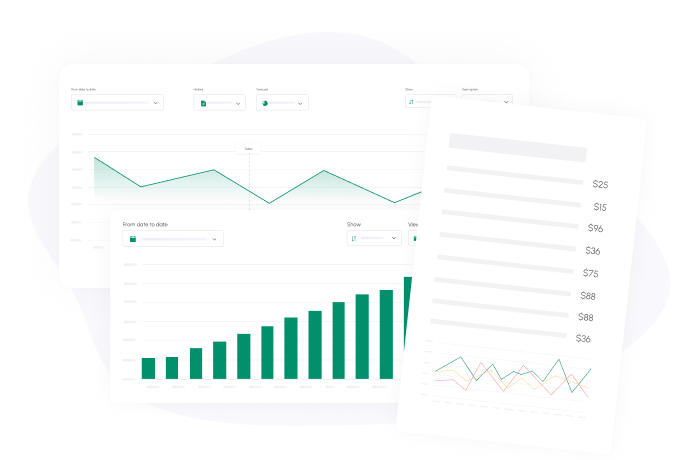

Retained cash flow is something that every business should work on calculating. Why? We’re going to explain the reason you need to work on learning the retained cash flow calculation, how to calculate this key metric and even the advantages of it for your business.
What is Retained Cash Flow (RCP)?
Before going any further, it’s important to explain the concept of retained cash flow (RCP). RCP, at its most basic form, is the measurement of the change during a specific period in:
- Cash
- Cash equivalent assets
RCP shows you the difference in the cash coming in and going out during the period. However, this is not the same thing as cash flow. Instead, it is the actual remaining cash that you have after:
- Paying cash for expenses
- Returning cash to suppliers
- Paying dividends
- Etc.
Additionally, RCP is an indicator of cash that you have left to reinvest in your future growth. If you’ve heard the term retained earnings before, you may be wondering what the difference is between the two.
Retained Cash Flow vs. Retained Earnings
Retained earnings cash flow and retained earnings are very different.
How?
Retained earnings do not involve cash flow. Instead, it’s a measurement of your profit and losses since a certain date. Profits that you make but do not pay out in dividends and expenses are retained earnings. Let's look at an example:
- Your business has $10 million in profits
- You pay out $4 million in dividends and expenses
- $10 million - $4 million = $6 million in retained earnings
So, for the point of this article, you will not be worrying about your retained earnings at all. You’re also unlikely to find your retained earnings on cash flow statements.
Now that you know the difference between retained earning cash flow and retained earnings, let’s take a look at how you can begin using this metric in your own business.
How is Retained Cash Flow Used?
RCP is used to help a company measure its financial status. You can use RCP to gain deeper insight into:
- Revenue
- Expenses
- However, you’ll also learn about your company’s budget and how efficient it is. If you have positive RCP, it means that your business will have sustainable growth and is financially healthy.
Why?
RCP is money that is often put back into the business through reinvesting. Using the example above, the business may have $6 million to use for:
- Growth
- Expenses
- Expansion
- Leverage in negotiations
- Etc.
If RCP is negative or minimal, the money may also be retained and not reinvested. Instead, the cash may be kept and used to satisfy debts or keep operations going.
Finally, let’s take a look at the retained cash flow calculation so that you can begin using this metric in your own business.
How to Calculate Retained Cash Flow?
Using the basic example above, you can start to figure out how to calculate RCP. However, let’s walk through the retained cash flow formula and go through the step-by-step process that you can use to begin your calculations.
Retained Cash Flow Formula
You may have a retained earnings adjustment on cash flow statement, but if you do not, you can begin following the steps below:
- Run or obtain your cash flow statement.
- Gather your past cash flow statement.
- Determine RCP for both statements by:
a. Calculating starting cash and cash equivalents
b. Subtracting dividend payments c. Subtracting cash expenses - Subtract the past statement’s calculation from the current statement’s figure
You can also use software to help you calculate the cash flow and RCP much easier. There are also advantages to calculating this type of cash flow in your business.
Advantages Of Calculating the Retained Cash Flow
Cash flow in business is always important, but we truly narrow down cash when we look at RCP. The reason to begin using RCP is for:
- Growing your business
- Reinvesting money into the business
If you know how much RCP you have, there’s always an opportunity to improve operations. Perhaps you need to cut dividend payments or you need to find ways to keep more cash in your business’ coffers.
For example, you may need to start paying using credit or negotiate better terms with suppliers.
With that said, paying in cash means that you do not have interest payments and can retain higher RCP over the long term. If you have an abundance of cash to pay cash for expenses, it’s often in the best interest of the business so long as your cash flow remains healthy.
Improving Retained Cash Flow for Your Business
Knowing the retained cash flow calculation means that now you can take the time to improve this key metric. A few of the ways that you can begin to improve RCP include:
- Focus on cash flow-increasing activities. You can increase cash flow in numerous ways:
- Raise your prices to bring more money into the business without increasing expenses
- Negotiate better rates with suppliers to lower expenses
- Reduce costs in any way possible
- Streamline payments, such as using direct debit to ensure that you don’t make late payments
- Work on debt management to improve overall financial health
Of course, many large businesses that pay cash dividends to their stockholders will also decide to stop dividends or lower payouts in times of low RCP. You may need to make this same decision in your business, but you will need to consider cutting dividend payouts greatly.
Every business owner should try and find ways to handle their cash flow better.
How to Handle Cash Flow?
Handling cash flow is an art, and it takes a lot of crunching numbers, knowing your customer’s payment habits and also the steps to take to improve cash flow. First and foremost, you should use a platform like Cash Flow Frog to help you rapidly create cash flow statements.
When you have access to the data available about your cash flow, you’ll have an easier time:
- Projecting your future cash flow and how to make changes in times of low or negative cash flow
- Analyzing your financial stance so that you can seek finding
- Making smart, data-driven decisions about your business’s operations
Handling cash flow goes well beyond just reviewing the numbers and accepting the figure on the screen. Internal accountants and decision-makers should use the information provided in tools like
Cash Flow Frog to:
- Learn where money is going out of the business.
- Find bottlenecks that are causing low cash flow.
- Gain insights into customers and their payment habits.
A few of the ways that you can work on your overall cash flow are:
- Pay your bills in the most strategic way possible. For example, you don’t need to pay bills early if you’re running low on cash. However, you do want to avoid late payments and having to deal with paying interest or even souring your relationship with a supplier.
- Collect all of your account receivables as quickly as possible. You may want to create automated invoice systems and reminders that will allow you to send out invoices immediately when products or goods are sold. You can also have systems for automatic invoice reminders.
- Be very cautious of extending credit to others. Credit can help you create lasting relationships with other businesses, but you will also want to review terms and ensure that the credit isn’t causing you cash flow problems.
- Work with suppliers and try to negotiate your payment terms. You may be able to negotiate better terms or even better prices.
- Consider taking out a line of credit or using credit cards to make payments. If you do this, you can free up your cash flow and make it easier to keep cash in the bank when your cash flow is already low.
If you’ve done all of this, now it’s time to start making money using the industry’s state-of-the-art cash flow solution.
Ready to Make Money with Cash Flow Frog?
The best cash flow forecasting software can help you make money. How? When you have full control of your cash flow, you can make smarter business decisions. For example, if you know what your RCP is, you can decide to:
- Plan for future growth
- Reduce expenses to raise RCP
- Reinvest in the business
In all of these scenarios, RCP will help you grow and expand your business. As a well-managed business grows, RCP will lead to more opportunities and money.
Cash Flow Frog provides world-class insight into your business’s operations with:
- Customer insights that can be used to help you boost earnings by taking action against slow-paying customers
- Potential future cash flow issues so that you don’t use RCP for reinvestment at a time when you may need the cash for operations
- Fast and easy methods to generate cash flow reports
Through Cash Flow Frog, many businesses will forecast their cash flow for future periods and then calculate RCP potential. Knowing how much cash you have to invest and potential cash issues will help you maintain financial health in the long term.
Related posts:
You may be interested:
New:













